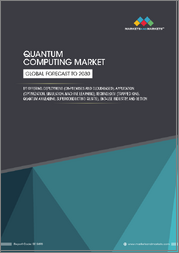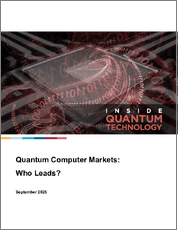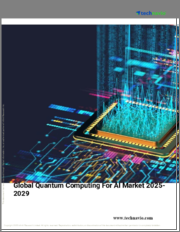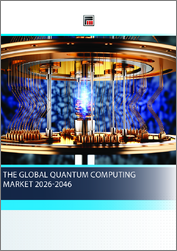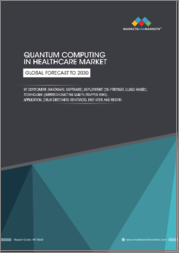
|
시장보고서
상품코드
1756018
세계의 운송용 양자 컴퓨팅 시장 평가 : 용도별, 구성요소별, 기술별, 최종사용자별, 지역별, 기회 및 예측(2018-2032년)Global Quantum Computing in Transportation Market Assessment, By Application, By Component, By Technology, By End-user, By Region, Opportunities and Forecast, 2018-2032F |
||||||
전 세계 운송용 양자 컴퓨팅 시장 규모는 2024년 4,662만 달러에서 2032년 1억 9,465만 달러에 달할 것으로 예상되며, 2025-2032년 예측 기간 동안 19.56%의 연평균 성장률을 보일 것으로 예상됩니다. 역동적인 경로, 변동하는 수요, 시시각각 변하는 배송 등 물류 네트워크가 점점 더 복잡해짐에 따라 기존 컴퓨팅은 방대한 양의 데이터와 가변성을 처리하는 데 어려움을 겪고 있습니다. 방대한 데이터세트를 처리하고 기존 시스템보다 기하급수적으로 빠르게 최적화 문제를 해결할 수 있는 탁월한 능력을 가진 양자 컴퓨팅은 설득력 있는 솔루션을 제공합니다. 양자 어닐링, 양자 고전-양자 하이브리드 프레임워크의 발전, 주요 기술 및 물류 기업의 투자 증가 등에 힘입어 향후 10년간 시장이 크게 성장할 것으로 예상됩니다.
가장 큰 성장 요인 중 하나는 화물 운송 및 창고 관리에서 실시간 경로 최적화 및 예측 분석에 대한 수요 증가입니다. 주요 물류 기업들은 라스트 마일 배송 문제, 창고 재고 최적화, 국경 간 화물 조정 등을 해결하기 위해 양자 솔루션을 모색하고 있습니다. 또한 북미, 유럽, 아시아 일부 지역, 특히 일본과 싱가포르 등의 지역에서는 정부의 지원 정책에 따라 자금 지원과 인프라 지원이 이루어지고 있어 채택이 가속화되고 있습니다. 또한, 클라우드 기반 플랫폼을 통해 양자 컴퓨팅이 통합되면서 진입장벽이 낮아져 중견기업도 대규모 설비투자 없이도 실험과 시제품을 제작할 수 있게 되었습니다. 하지만 시장에는 여전히 제약 요인이 존재합니다. 양자 하드웨어와 관련된 높은 비용, 숙련된 인력 부족, 상업적 양자 활용의 초창기라는 점이 큰 과제입니다. 또한, 오류 수정, 알고리즘의 안정성, 하드웨어의 표준화 문제가 확장성 및 광범위한 배포를 방해하고 있습니다.
다른 많은 신기술과 달리, 물류 분야의 양자 컴퓨팅은 비용 효율성, 지속가능성, 고객 만족도에 직접적인 영향을 미치는 구체적이고 단기적인 사용 사례를 제공합니다. 시범 프로그램의 성공 사례와 양자 기술 기업과 주요 물류 기업 간의 전략적 파트너십이 증가함에 따라, 시장은 예상보다 훨씬 더 빨리 실험적인 단계에서 실용적인 단계로 전환될 것으로 예상됩니다.
예를 들어, 2025년 4월, 집적 포토닉스 및 양자 광학 기술의 선두주자인 Quantum Computing Inc.(QCi)는 유명 자동차 제조업체에 EmuCore 저수지 컴퓨터를 판매 및 출하한다고 발표했습니다. 이 장치는 고객의 연구개발에 활용될 예정입니다.
필드 프로그래머블 게이트 어레이(FPGA)에 구축된 EmuCore는 엣지 컴퓨팅 시나리오에서 머신러닝을 활용하고 처리 워크로드를 검증할 수 있는 안전하고 유연하며 에너지 효율이 높은 플랫폼을 제공합니다. 이를 통해 자동차 제조업체는 첨단 애플리케이션을 탐색하고, AI 및 센서 집약적인 환경에서 높은 와트당 성능을 기대할 수 있는 QCi의 PCIe 기반 포토닉 리저버 컴퓨팅 유닛의 테스트베드 역할을 할 수 있게 됐습니다.
세계의 운송용 양자 컴퓨팅 시장에 대해 조사 분석했으며, 시장 규모와 예측, 시장 역학, 주요 기업 개요 등의 정보를 전해드립니다.
목차
제1장 프로젝트 범위와 정의
제2장 조사 방법
제3장 미국 관세의 영향
제4장 주요 요약
제5장 고객의 소리
- 기술적인 전문 지식과 실적
- 용도 적합성과 이용 사례 관련성
- 확장성과 하드웨어 준비도
- 생태계와 파트너십
제6장 세계의 운송용 양자 컴퓨팅 시장 전망(2018-2032년)
- 시장 규모 분석과 예측
- 금액
- 시장 점유율 분석과 예측
- 용도별
- 교통 관리 시스템
- 물류 최적화
- 구성요소별
- 하드웨어
- 소프트웨어
- 서비스
- 기술별
- 양자 어닐링
- 양자 게이트 모델
- 최종사용자별
- 공공교통기관
- 화물·물류
- 자동차
- 항공우주
- 기타
- 지역별
- 북미
- 유럽
- 아시아태평양
- 남미
- 중동 및 아프리카
- 시장 점유율 분석 : 기업별(상위 5개사와 기타)(금액)(2024년)
- 용도별
- 시장 맵 분석(2024년)
- 용도별
- 구성요소별
- 기술별
- 최종사용자별
- 지역별
제7장 북미의 운송용 양자 컴퓨팅 시장 전망(2018-2032년)
- 시장 규모 분석과 예측
- 금액
- 시장 점유율 분석과 예측
- 용도별
- 교통 관리 시스템
- 물류 최적화
- 구성요소별
- 하드웨어
- 소프트웨어
- 서비스
- 기술별
- 양자 어닐링
- 양자 게이트 모델
- 최종사용자별
- 공공교통기관
- 화물 운송·물류
- 자동차
- 항공우주
- 기타
- 점유율 : 국가별
- 미국
- 캐나다
- 멕시코
- 용도별
- 각국의 시장 평가
- 미국의 운송용 양자 컴퓨팅 시장 전망(2018-2032년)
- 시장 규모 분석과 예측
- 시장 점유율 분석과 예측
- 캐나다
- 멕시코
- 미국의 운송용 양자 컴퓨팅 시장 전망(2018-2032년)
제8장 유럽의 운송용 양자 컴퓨팅 시장 전망(2018-2032년)
- 독일
- 프랑스
- 이탈리아
- 영국
- 러시아
- 네덜란드
- 스페인
- 튀르키예
- 폴란드
제9장 아시아태평양의 운송용 양자 컴퓨팅 시장 전망(2018-2032년)
- 인도
- 중국
- 일본
- 호주
- 베트남
- 한국
- 인도네시아
- 필리핀
제10장 남미의 운송용 양자 컴퓨팅 시장 전망(2018-2032년)
- 브라질
- 아르헨티나
제11장 중동 및 아프리카의 운송용 양자 컴퓨팅 시장 전망(2018-2032년)
- 사우디아라비아
- 아랍에미리트
- 남아프리카공화국
제12장 수급 분석
제13장 밸류체인 분석
제14장 Porter's Five Forces 분석
제15장 PESTLE 분석
제16장 시장 역학
- 시장 성장 촉진요인
- 시장 과제
제17장 시장 동향과 발전
제18장 정책과 규제 상황
제19장 사례 연구
제20장 경쟁 구도
- 시장 리더 상위 5개사 경쟁 매트릭스
- 상위 5개사 SWOT 분석
- 주요 기업 상위 10개사 상황
- IBM Corporation
- Google LLC
- Microsoft Corporation
- Honeywell International Inc.
- Intel Corporation
- D-Wave Systems Inc.
- Quantinuum Ltd.
- Rigetti Computing
- Quantum Computing Inc.
- Xanadu Quantum Technologies Inc.
제21장 전략적 제안
제22장 조사 회사 소개 및 면책사항
ksm 25.07.03Global quantum computing in transportation market is projected to witness a CAGR of 19.56% during the forecast period 2025-2032, growing from USD 46.62 million in 2024 to USD 194.65 million in 2032F, owing to the pressing need for faster, more efficient supply chain operations. As logistics networks become increasingly complex, with dynamic routes, fluctuating demand, and time-sensitive deliveries, classical computing struggles to handle the sheer volume and variability of data. Quantum computing, with its unparalleled ability to process vast datasets and solve optimization problems exponentially faster than traditional systems, offers a compelling solution. The market is poised for substantial growth over the next decade, supported by advancements in quantum annealing, hybrid quantum-classical frameworks, and increased investments from both tech giants and logistics firms.
One of the most significant growth drivers are the increasing demand for real-time route optimization and predictive analytics in freight and warehousing. Major logistics companies are exploring quantum solutions to tackle last-mile delivery issues, warehouse inventory optimization, and cross-border freight coordination. Additionally, supportive government policies in regions such as North America, Europe, and parts of Asia, especially Japan and Singapore, are providing funding and infrastructure support to accelerate adoption. The integration of quantum computing through cloud-based platforms has also lowered entry barriers, allowing even mid-sized firms to experiment and prototype without heavy capital investment. However, the market is not without its restraints. High costs associated with quantum hardware, the lack of a skilled workforce, and the nascent stage of commercial quantum applications pose significant challenges. Moreover, issues related to error correction, algorithm stability, and hardware standardization continue to hamper scalability and broader deployment.
Unlike many other emerging technologies, quantum computing in logistics offers tangible, short-term use cases that directly impact cost-efficiency, sustainability, and customer satisfaction. With a growing number of successful pilot programs and strategic partnerships among quantum tech firms and logistics leaders, the market is expected to move from experimental to actionable much sooner than anticipated.
For instance, in April 2025, Quantum Computing Inc. (QCi), a leader in integrated photonics and quantum optics technology, announced the sale and shipment of its EmuCore reservoir computer to a prominent automotive manufacturer. The device will be utilized by the customer for research and development initiatives.
EmuCore, built on a field-programmable gate array (FPGA), offers a secure, flexible, and energy-efficient platform for leveraging machine learning in edge computing scenarios and validating processing workloads. This deployment allows the automotive manufacturer to explore advanced applications and serve as a testbed for QCi's upcoming PCIe-based photonic reservoir computing units, which are expected to deliver superior performance per watt in AI and sensor-intensive environments.
Advanced Optimisation for Complex Logistics Drives Market Growth
Quantum computing has emerged as a transformative force in optimization-heavy sectors such as transportation and logistics. These domains feature NP-hard problems, such as multivehicle routing, dynamic schedule adjustments, and cargo allocation, that classical systems struggle to solve efficiently at scale. Quantum annealing and hybrid quantum-classical methods can evaluate exponentially larger solution spaces in parallel.
For instance, in late 2024, D-Wave released a logistics-routing datasheet highlighting real-world deployments of its quantum annealer for vehicle routing across delivery networks, public transit, and tour vehicles. According to their findings, quantum-enabled routing reduced travel time and fuel consumption by analyzing complex, dynamic variables in real time. For example, D-Wave's annealer had been deployed to optimize driver scheduling and parcel-truck routing for Hermes Germany, coordinating trucks from 50 depots to 17,000 delivery points. This demonstrates immediate, practical gains: lower operational costs, shortened delivery times, and reduced environmental impact.
These implementations move quantum beyond theoretical promise to measurable efficiency, enabling transport operators to process dynamic constraints such as traffic delays or emergent disruptions on the fly. By handling large-scale route recalculations swiftly, quantum systems significantly enhance responsiveness in logistics chains. Quantum optimization in transportation is growing from pilot stages into early-stage rollouts, attracting interest from major LSPs (logistics service providers) and delivery firms, driving the global market demand.
Enhancing Resilience, Sustainability, And Emissions Reduction Leads Market Growth
Global transportation systems are facing mounting pressure to decarbonize and make more efficient use of resources. Governments and transit agencies are establishing net-zero targets, then tightening fuel-efficiency and congestion norms, usually. Also, simulation and optimization based on quantum computing could make a great impact on these goals.
For instance, the UK Department for Transport released a 2024 report, estimating that up to USD 10.24 billion in value can be opened by quantum-enabled traffic and route optimization by 2035, while emissions savings could contribute USD 3.58 billion annually in reduced congestion costs. The report also draws attention to dynamic route recalculation that is capable of constantly adjusting to the flow of traffic and a surge in demand, aligning directly with emissions reduction and operational resilience goals.
Quantum-enabled planning of bus, municipal or delivery routes that adapt to traffic and avoid road disruption even while idling away and returning. Fleet managers will be able to deploy cars more efficiently, reduce the amount of fuel they use, and lower the amount of greenhouse gases they emit. In addition, the UK plan merges with international governance frameworks, such as the UN's Paris Agreement, by harmonizing quantum technology's role in green transitions.
For this driver of change, which has implications reaching far beyond logistics as cities and countries scale up electrification, smart-transport infrastructure and EV fleet deployment, quantum optimization becomes a critical tool to keep service quality up and meet environmental goals. It is a key foundation stone of next-gen sustainable transport systems.
Dynamic Optimization of Urban Traffic Signals Drives Market Growth
Quantum computing, particularly quantum-inspired optimization, is beginning to redefine how cities manage urban traffic, with real-time control of signal timings becoming a key growth frontier. Unlike traditional systems that follow present signal patterns, quantum solutions can evaluate thousands of timing combinations across multiple intersections simultaneously and adapt on the fly. This enables smarter distribution of green-light intervals, reduction of congestion, and shorter wait times.
For instance, in October 2024, the Port of Hamburg deployed a quantum-inspired Digital Annealer system, known as the MOZART project, to optimize traffic light timings across a congested port area. In a pilot wrapped up, the system dynamically adjusted signal phases across multiple intersections in near real-time. Early results showed improved traffic flow and reduced idling times during peak periods, demonstrating how quantum-based optimization can enhance existing infrastructure without physical expansion.
North America leads the Global Quantum Computing in Transportation Market
North America currently dominates the global quantum computing in logistics market in terms of revenue, accounting for a major share, driven by strong government funding, technological leadership, and early adoption by logistics giants. The U.S. and Canada lead due to initiatives such as the U.S. National Quantum Initiative Act, which has allocated USD 1.2 billion for quantum R&D, and Canada's National Quantum Strategy, fostering public-private partnerships. Major tech firms such as IBM Quantum and D-Wave are headquartered in the region, collaborating with logistics players to test quantum solutions.
For instance, in 2024, Amazon.com, Inc. integrated quantum algorithms via AWS Braket to enhance warehouse automation. It includes features such as Robotic path planning for pick-and-place systems, real-time inventory slotting to reduce retrieval times and Predictive labor allocation using quantum machine learning.
Impact of the U.S. Tariff on Global Quantum Computing in Transportation Market
U.S. tariffs on imported semiconductors, superconducting materials, and specialized electronic components can raise the cost of manufacturing and scaling quantum hardware. This directly impacts companies that rely on global supply chains for essential quantum computing parts, slowing down production and increasing end-user pricing.
Tariffs can create trade tensions and restrict the smooth flow of quantum technology and knowledge across borders. This affects international research partnerships, joint ventures, and vendor relationships, especially when logistics players in tariff-targeted countries hesitate to adopt U.S. based solutions.
Quantum computing applications in logistics often rely on shared technological developments between the U.S. and other innovation hubs. Tariff impositions may slow the transfer of quantum-enabled logistics platforms globally, affecting implementation timelines and increasing regional disparities.
Key Players Landscape and Outlook
The competitive landscape of the global quantum computing in logistics market is characterized by a blend of established technology giants and emerging quantum-focused firms. Competition among top players primarily revolves around technological capability, qubit performance, error correction methods, algorithm efficiency, and scalability of quantum hardware and software platforms. Additionally, the ability to offer end-to-end solutions-including cloud-based quantum access, hybrid quantum-classical algorithms, and integration with existing logistics systems-plays a vital role in determining market positioning. Strategic collaborations, R&D investments, intellectual property strength, and partnerships with logistics providers are also key differentiators. The market outlook remains promising, with increasing interest from logistics companies seeking to leverage quantum computing for solving complex routing, supply chain optimization, and predictive analytics challenges. As quantum hardware matures and quantum-as-a-service models gain traction, competition is expected to intensify, leading to broader adoption and commercialization. However, market success will heavily depend on overcoming current technological constraints, regulatory clarity, and demonstrating real-world value across logistics functions.
In June 2025, at the 49th annual Honeywell Users Group event, Honeywell International Inc. introduced a new suite of digital technologies leveraging artificial intelligence, aimed at accelerating the transition from automation to autonomy in industrial sectors. Among the highlights were the launch of Honeywell Cyber Proactive Defense and the Honeywell OT Security Operations Center, AI-enabled cybersecurity solutions specifically designed to strengthen operational technology (OT) environments against increasingly sophisticated cyber threats. According to the company, these offerings help organizations minimize cyberattack risks, enhance resiliency, and ensure uninterrupted industrial operations.
Table of Contents
1. Project Scope and Definitions
2. Research Methodology
3. Impact of U.S. Tariffs
4. Executive Summary
5. Voice of Customers
- 5.1. Technical Expertise and Track Record
- 5.2. Application Fit and Use Case Relevance
- 5.3. Scalability and Hardware Readiness
- 5.4. Ecosystem and Partnerships
6. Global Quantum Computing in Transportation Market Outlook, 2018-2032F
- 6.1. Market Size Analysis & Forecast
- 6.1.1. By Value
- 6.2. Market Share Analysis & Forecast
- 6.2.1. By Application
- 6.2.1.1. Traffic Management Systems
- 6.2.1.2. Logistics Optimization
- 6.2.2. By Component
- 6.2.2.1. Hardware
- 6.2.2.2. Software
- 6.2.2.3. Services
- 6.2.3. By Technology
- 6.2.3.1. Quantum Annealing
- 6.2.3.2. Quantum Gate Model
- 6.2.4. By End-user
- 6.2.4.1. Public Transportation
- 6.2.4.2. Freight & Logistics
- 6.2.4.3. Automotive
- 6.2.4.4. Aerospace
- 6.2.4.5. Others
- 6.2.5. By Region
- 6.2.5.1. North America
- 6.2.5.2. Europe
- 6.2.5.3. Asia-Pacific
- 6.2.5.4. South America
- 6.2.5.5. Middle East and Africa
- 6.2.6. By Company Market Share Analysis (Top 5 Companies and Others - By Value, 2024)
- 6.2.1. By Application
- 6.3. Market Map Analysis, 2024
- 6.3.1. By Application
- 6.3.2. By Component
- 6.3.3. By Technology
- 6.3.4. By End-user
- 6.3.5. By Region
7. North America Quantum Computing in Transportation Market Outlook, 2018-2032F
- 7.1. Market Size Analysis & Forecast
- 7.1.1. By Value
- 7.2. Market Share Analysis & Forecast
- 7.2.1. By Application
- 7.2.1.1. Traffic Management Systems
- 7.2.1.2. Logistics Optimization
- 7.2.2. By Component
- 7.2.2.1. Hardware
- 7.2.2.2. Software
- 7.2.2.3. Services
- 7.2.3. By Technology
- 7.2.3.1. Quantum Annealing
- 7.2.3.2. Quantum Gate Model
- 7.2.4. By End-user
- 7.2.4.1. Public Transportation
- 7.2.4.2. Freight and Logistics
- 7.2.4.3. Automotive
- 7.2.4.4. Aerospace
- 7.2.4.5. Others
- 7.2.5. By Country Share
- 7.2.5.1. United States
- 7.2.5.2. Canada
- 7.2.5.3. Mexico
- 7.2.1. By Application
- 7.3. Country Market Assessment
- 7.3.1. United States Quantum Computing in Transportation Market Outlook, 2018-2032F*
- 7.3.1.1. Market Size Analysis & Forecast
- 7.3.1.1.1. By Value
- 7.3.1.2. Market Share Analysis & Forecast
- 7.3.1.2.1. By Application
- 7.3.1.2.1.1. Traffic Management Systems,
- 7.3.1.2.1.2. Logistics Optimization
- 7.3.1.2.2. By Component
- 7.3.1.2.2.1. Hardware
- 7.3.1.2.2.2. Software
- 7.3.1.2.2.3. Services
- 7.3.1.2.3. By Technology
- 7.3.1.2.3.1. Quantum Annealing
- 7.3.1.2.3.2. Quantum Gate Model
- 7.3.1.2.4. By End-user
- 7.3.1.2.4.1. Public Transportation
- 7.3.1.2.4.2. Freight and Logistics
- 7.3.1.2.4.3. Automotive
- 7.3.1.2.4.4. Aerospace
- 7.3.1.2.4.5. Others
- 7.3.1.2.1. By Application
- 7.3.1.1. Market Size Analysis & Forecast
- 7.3.2. Canada
- 7.3.3. Mexico
- 7.3.1. United States Quantum Computing in Transportation Market Outlook, 2018-2032F*
All segments will be provided for all regions and countries covered
8. Europe Quantum Computing in Transportation Market Outlook, 2018-2032F
- 8.1. Germany
- 8.2. France
- 8.3. Italy
- 8.4. United Kingdom
- 8.5. Russia
- 8.6. Netherlands
- 8.7. Spain
- 8.8. Turkey
- 8.9. Poland
9. Asia-Pacific Quantum Computing in Transportation Market Outlook, 2018-2032F
- 9.1. India
- 9.2. China
- 9.3. Japan
- 9.4. Australia
- 9.5. Vietnam
- 9.6. South Korea
- 9.7. Indonesia
- 9.8. Philippines
10. South America Quantum Computing in Transportation Market Outlook, 2018-2032F
- 10.1. Brazil
- 10.2. Argentina
11. Middle East and Africa Quantum Computing in Transportation Market Outlook, 2018-2032F
- 11.1. Saudi Arabia
- 11.2. UAE
- 11.3. South Africa
12. Demand Supply Analysis
13. Value Chain Analysis
14. Porter's Five Forces Analysis
15. PESTLE Analysis
16. Market Dynamics
- 16.1. Market Drivers
- 16.2. Market Challenges
17. Market Trends and Developments
18. Policy and Regulatory Landscape
19. Case Studies
20. Competitive Landscape
- 20.1. Competition Matrix of Top 5 Market Leaders
- 20.2. SWOT Analysis for Top 5 Players
- 20.3. Key Players Landscape for Top 10 Market Players
- 20.3.1. IBM Corporation
- 20.3.1.1. Company Details
- 20.3.1.2. Key Management Personnel
- 20.3.1.3. Products and Services
- 20.3.1.4. Financials (As Reported)
- 20.3.1.5. Key Market Focus and Geographical Presence
- 20.3.1.6. Recent Developments/Collaborations/Partnerships/Mergers and Acquisition
- 20.3.2. Google LLC
- 20.3.3. Microsoft Corporation
- 20.3.4. Honeywell International Inc.
- 20.3.5. Intel Corporation
- 20.3.6. D-Wave Systems Inc.
- 20.3.7. Quantinuum Ltd.
- 20.3.8. Rigetti Computing
- 20.3.9. Quantum Computing Inc.
- 20.3.10. Xanadu Quantum Technologies Inc.
- 20.3.1. IBM Corporation
Companies mentioned above DO NOT hold any order as per market share and can be changed as per information available during research work.






